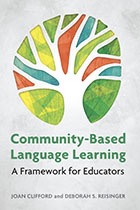
1 Selected Items
Select an item by clicking its checkboxDate Reviewed: April 15, 2020
Can we escape political injustice when we learn a language? Most people would say that language and justice issues are separate, but according to this book’s authors, Joan Clifford and Deborah Reisinger, learning another language cannot be completed by simply gaining a linguistic skill in a classroom. They reason that language learners cannot overlook the diverse cultural and social factors of those who live in their own language community. Therefore, the book introduces the importance of local community-based learning for second-language learners (CBLL, as the authors abbreviate) to build a better educational framework.
Specifically, Clifford and Reisinger, US-based language professors, pay attention to the unique experiences of second-language student learners with relation to their local communities in America. As described in Chapter Four, speaking the dominant language in a society gives one access to the society’s dominant culture. For example, in the United States, English holds such a power. The problem is that “not all ways of speaking English are created equal in certain social spaces” (101). On the surface, second-language English speakers seem unimpeded in their access to America’s educational and health services, but actually their different accents and cultures are often undervalued “in the school system which prizes and reproduces dominant (white, English-speaking) culture” (101). That is, for second-language learners, where their living language communities are located, economically, socially, and politically, matters when they try to access America’s dominant cultural group.
Although Clifford and Reisinger focus on the American learning situation and social injustice issues, their audience is not limited to American educators. Rather, by providing a better local community-based learning model, the authors hope that students will critically reflect and challenge problems which are imbued in their social structures. Regarding this, the book is not only useful for learning foreign language but also for other areas such as the missionary context where theological subjects are taught in English or in other languages.
Further, within this emphasis on local communities as a learning partner, for both students and teachers, learning another language allows students to encounter something more than language. That is, it can be a place for the students to experience a “dissonance” between their previous beliefs about their own community’s problems, and those that appear through CBLL conversation. For the teachers as well, this conversation offers a chance to reconsider their cultural privilege and power, and how this might affect their students who come from diverse communities.
Finally, the book means to create “brave spaces” for “genuine dialogue” between learners, educators, and communities by coping with their conflicts or tensions to deeply understand and challenge social injustice issues (140). To do this, the book structures each chapter with reflections for instructors and activities for students to provide a practical framework of CBLL. This book would be valuable for both educators and their students who are considering their communities as important learning partners with relation to their own ecclesial, social, and cultural context.
